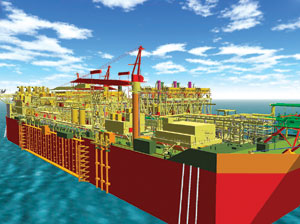 Technology from Europe: Technology from Europe:
France/Belgium
Software converts multiple CAD formats, produces 3D visualizations for Bonga
Upstream projects are significant users of multi-million-dollar CAD models to define surface production schemes. These concepts include fixed platforms, floating platforms and subsea equipment.
CAD models are generated throughout the design phase and used to build facilities. Every component, large and small, is designed by various drawing offices and then brought together into one model and visualized. Increasingly, these models have been produced in 3D, so that interference between designs can be checked. They are produced by drafting departments on inputs provided by engineers. Seldom do the engineers get to handle or alter the models in real time to see the effects of their designs on projects.
A Belgian company, VRcontext s.a., is trying to change these practices with its Walkinside software. This software takes multiple CAD formats, and converts and produces 3D visualizations of the models. The product uses proprietary “collision detection” and “gravity” technology to enhance the visualization, so that the user can interact with the models. Opening valves, moving objects, etc., are now all possible within the 3D model.
A recent example of this software's usage is the visualization of Shell Deepwater's Bonga field development, offshore Nigeria. The Bonga field development is 150 km (93 mi) offshore Nigeria in what is defined as deep water. This field will produce in excess of 1 billion bbl of oil in the coming 20 years. Its cost is in excess of $2 billion.
 |
The Bonga field FPSO is just one example of how new software is able to convert multiple CAD formats and produce 3D visualizations of planned facilities.
|
|
The company was able to use Shell's CAD-produced drawings (from Houston) to connect various parts of the development together into an interactive 3D visualization of the whole project.
The visualization was constructed by taking CAD files from contractors building the facilities. Each contractor had its own preferred, in-house CAD package, ranging from PDMS, MicroStation and Autocad to ProE. All files were used with no manipulation or editing of content. They were imported into Micro-Station and passed through the Walkinside converter. The software engine then output a 3D, VR model that could be navigated with a standard keyboard and mouse.
This VR model generated by the software was one of the world's largest, covering more than 100 sq km (39 sq mi) and containing more than 100 million triangles. One can also dynamically load additional VR models.
The visualization was built on both SGI Irix64 and Windows operating systems. The software's SGI version was necessary to allow Shell to show the models in its nine fixed Virtual Reality Centers around the world. It also allows the CAD models to be integrated with the models of the oil reservoirs below the surface. The Windows platform offers a cheaper alternative to UNIX, enabling future desktop 3D visualization to be possible. 
|

 Technology from Europe:
Technology from Europe:

